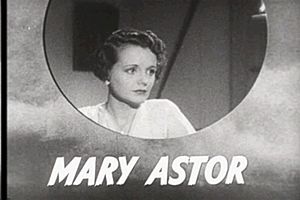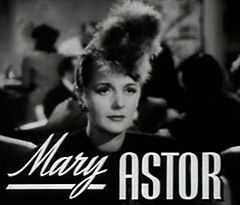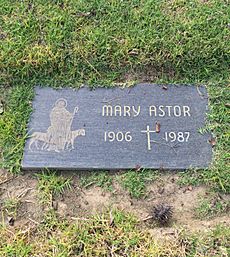Mary Astor facts for kids
Quick facts for kids
Mary Astor
|
|
|---|---|

Astor in 1933
|
|
| Born |
Lucile Vasconcellos Langhanke
May 3, 1906 Quincy, Illinois, U.S.
|
| Died | September 25, 1987 (aged 81) Los Angeles, California, U.S.
|
| Resting place | Holy Cross Cemetery |
| Occupation | Actress |
| Years active | 1920–1964 |
| Political party | Democratic |
| Spouse(s) |
Kenneth Hawks
(m. 1928; Franklyn Thorpe
(m. 1931; div. 1935)Manuel del Campo
(m. 1936; div. 1941)Thomas Gordon Wheelock
(m. 1945; div. 1955) |
| Children | 2 |
| Relatives |
|
| Signature | |
Mary Astor (born Lucile Vasconcellos Langhanke; May 3, 1906 – September 25, 1987) was a famous American actress. She had a long career in movies, TV, and on stage. Many people remember her best for her role as Brigid O'Shaughnessy in the classic film The Maltese Falcon (1941).
Mary Astor started acting as a teenager in silent movies in the early 1920s. When movies started having sound (called talkies), her voice was first thought to be too deep. She took a break from acting for a year. After performing in a play, she got new movie offers and continued her career in sound films. She even won an Academy Award for Best Supporting Actress for playing a concert pianist in The Great Lie (1941).
Mary Astor worked for Metro-Goldwyn-Mayer (MGM) for much of the 1940s. She kept acting in films, on television, and on stage until she retired in 1964. She also wrote five novels. Her autobiography, My Story, was a very popular book. Her later book, A Life on Film, was also a bestseller and was about her acting career.
Contents
Early Life and First Steps in Acting
Mary Astor was born Lucile Vasconcellos Langhanke in Quincy, Illinois. She was the only child of Otto Ludwig Langhanke and Helen Marie de Vasconcellos. Both of her parents were teachers. Her father came to the United States from Berlin, Germany, in 1891. Her mother was born in Jacksonville, Illinois, and had Portuguese family roots. They got married in 1904.
Mary's father taught German at Quincy High School. Her mother, who always wanted to be an actress, taught drama. Mary was home-schooled and learned to play the piano from her father. Her piano skills were very helpful later when she played the piano in her films The Great Lie and Meet Me in St. Louis.
In 1919, when Mary was 13, she sent a photo of herself to a beauty contest. It was for Motion Picture Magazine, and she became a semifinalist. When she was 15, her family moved to Chicago, Illinois. There, Mary took drama lessons and acted in local plays. The next year, she entered the photo contest again and became a finalist. Her father then moved the family to New York City so Mary could act in movies. He managed her career for many years.
A photographer in New York, Charles Albin, saw her picture. He asked the young girl, nicknamed "Rusty" for her auburn hair, to pose for him. These photos were seen by Harry Durant of Famous Players-Lasky. Mary signed a six-month contract with Paramount Pictures. Her name was changed to Mary Astor during a meeting with important film people.
Starting in Silent Films
Mary Astor's first screen test was directed by the famous actress Lillian Gish. Lillian was so impressed that she filmed a lot of Mary acting. Mary made her first movie appearance at age 14 in the 1921 film Sentimental Tommy. However, her small part was cut from the final movie. Paramount did not renew her contract.
She then appeared in some short films based on famous paintings. She earned good reviews for a short film called The Beggar Maid in 1921. Her first full-length movie was John Smith (1922). That same year, she also starred in The Man Who Played God. In 1923, Mary and her parents moved to Hollywood.
After acting in several bigger roles, Paramount signed her again. This time, it was a one-year contract for $500 a week. After more movies, the famous actor John Barrymore saw her photo. He wanted her to be in his next movie. Mary was loaned to Warner Bros. and starred with him in Beau Brummel (1924). John Barrymore was much older and liked Mary. However, Mary's parents did not let them spend time alone. Mary was only 17 and still a minor. John Barrymore convinced her parents that his acting lessons needed privacy. This was the only way they could be alone. Their secret engagement ended because of her parents' strict rules. John Barrymore also became involved with another young actress, Dolores Costello, whom he later married.
In 1925, Mary's parents bought a large house called "Moorcrest" in the Hollywood hills. It was a Moorish style mansion with a lot of land. Mary's parents lived very well using her earnings. They also kept her almost like a prisoner in Moorcrest. Moorcrest is known for its unique style. It was built by Marie Russak Hotchener, who had no formal architecture training. The house mixes Moorish and Mission Revival styles. It has special features like art-glass windows and decorative tiles. Moorcrest has been renovated and is still standing today. Before Mary's parents bought it, Charlie Chaplin rented the house.
Mary's parents were not part of a special group called Theosophists, but they were friends with Marie Hotchener. Marie helped Mary get a small allowance of $5 a week. This was at a time when Mary was earning $2,500 a week! Marie also helped Mary get permission to go to work without her mother watching her. The next year, when Mary was 19, she left her parents' house. Marie helped her return by convincing Mary's father to give her a savings account with $500. She also got the freedom to come and go as she pleased. However, Mary did not get control of her full salary until she was 26 years old. At that point, her parents sued her for money. Mary settled the case by agreeing to pay her parents $100 a month.
Mary continued to act in movies for different studios. After her Paramount contract ended in 1925, she signed with Warner Bros. She acted with John Barrymore again in Don Juan (1926). In 1926, she was named one of the WAMPAS Baby Stars. This was a group of promising young actresses. Other stars in this group included Joan Crawford and Janet Gaynor.
Mary was loaned to Fox Film Corporation and starred in Dressed to Kill (1928). This movie got good reviews. She also starred in the comedy Dry Martini (1928). She later said that working on Dry Martini changed her way of thinking. When her Warner Bros. contract ended, she signed with Fox for $3,750 a week.
In 1928, she married director Kenneth Hawks at her family home, Moorcrest. He gave her a Packard car as a wedding gift. The couple moved into a home in Los Angeles. As movies changed to "talkies," Fox gave Mary a voice test. She failed because the studio thought her voice was too deep. This was probably due to early sound equipment. The studio let her go from her contract. She was out of work for eight months in 1929.
New Beginnings in Sound Films

During her time off, Mary Astor took voice and singing lessons. But she still didn't get any acting offers. Her friend, Florence Eldridge, helped her career. Florence was starring in a play called Among the Married. She suggested Mary for the second female lead role. The play was a success, and Mary's voice was praised as low and vibrant. She was happy to be working again, but her happiness did not last.
On January 2, 1930, her husband Kenneth Hawks was killed in a plane crash. Mary had just finished a play performance when Florence Eldridge told her the news. Mary was very upset. She stayed with Florence for a while, then soon returned to work. Shortly after her husband's death, she appeared in her first "talkie," Ladies Love Brutes (1930). She co-starred with her friend Fredric March.
While her career improved, her personal life remained hard. After several more movies, she suffered from delayed shock over her husband's death. She had a nervous breakdown. During her illness, she was cared for by Dr. Franklyn Thorpe. She married him on June 29, 1931. That year, she played Nancy Gibson in Smart Woman. She played a woman trying to get her husband back from another woman.
In May 1932, Mary and Franklyn bought a yacht and sailed to Hawaii. Mary was expecting a baby and gave birth in June in Honolulu. Their daughter was named Marylyn Hauoli Thorpe. Her first name combined her parents' names, and her middle name is Hawaiian. When they returned to Southern California, Mary worked as a freelance actress. She got an important role in MGM's Red Dust (1932). She starred with Clark Gable and Jean Harlow.
In late 1932, Mary signed a contract with Warner Bros. Meanwhile, her parents spent a lot of money and invested in the stock market, which often lost money. Mary called Moorcrest, her parents' home, a "white elephant" and refused to pay for its upkeep. In 1933, she had to ask the Motion Picture Relief Fund for help paying her bills. She played the female lead, Hilda Lake, in The Kennel Murder Case (1933). She co-starred with William Powell. A film critic called it a "masterpiece."
Mary soon became unhappy with her marriage to Franklyn Thorpe. He had a short temper and often pointed out her flaws. By 1933, she wanted a divorce. She took a break from movies and visited New York alone. While there, she met playwright George S. Kaufman. She wrote about their time together in her diary. Franklyn Thorpe found her diary and filed for divorce.
Custody Case and Career Boost
Dr. Franklyn Thorpe divorced Mary Astor in April 1935. A fight over the custody of their four-year-old daughter, Marylyn, got a lot of attention from the press in 1936. Even with the public attention, Mary Astor's career was not harmed. In fact, the publicity from the custody fight actually helped her career.
Mid-Career Successes
In 1937, Mary returned to the stage in popular plays. She also started performing regularly on radio. Over the next few years, she had roles in movies like The Prisoner of Zenda (1937) and John Ford's The Hurricane (1937). She also appeared in Midnight (1939) and Brigham Young (1940).
In John Huston’s famous film The Maltese Falcon (1941), Mary Astor played the clever character Brigid O'Shaughnessy. The movie was based on a novel by Dashiell Hammett. It also starred Humphrey Bogart, Peter Lorre, and Sydney Greenstreet.
For her acting in The Great Lie (also 1941), she won an Oscar for Best Supporting Actress. She played Sandra Kovak, a self-centered concert pianist. The film's main star was Bette Davis. Bette Davis wanted Mary Astor for the role after seeing her screen test. She saw Mary play Tchaikovsky's Piano Concerto No. 1. Bette Davis then asked Mary to help rewrite the script. She felt the script needed to be more interesting. Mary also followed Bette's advice and got a short haircut for the role.
In the movie scenes where she played the piano, the music was actually played by pianist Max Rabinovitch. Bette Davis purposely let Mary Astor shine in her important scenes. When Mary accepted her Oscar, she thanked Bette Davis and Tchaikovsky. Mary Astor and Bette Davis became good friends.
Even with these successes, Mary Astor did not become a top movie star. She always turned down offers to be the main star. She preferred to be a featured player, which meant less responsibility. She reunited with Humphrey Bogart and Sydney Greenstreet in John Huston's Across the Pacific (1942). Mary usually played serious roles, but she showed a talent for comedy in The Palm Beach Story (1942). In February 1943, Mary Astor's father, Otto Langhanke, passed away from a heart attack. His wife and daughter were with him.
That same year, Mary signed a seven-year contract with Metro-Goldwyn-Mayer (MGM). She later regretted this move. She was kept busy playing similar supporting roles. Mary called these roles "Mothers for Metro." After Meet Me in St. Louis (1944), the studio let her act on Broadway in a play. The play was not a success, but Mary received good reviews.
She was loaned to 20th Century Fox and played a rich widow in Claudia and David (1946). She was also loaned to Paramount to play Fritzi Haller in Desert Fury (1947). Fritzi was a tough owner of a saloon and casino. Mary's mother, Helen Langhanke, passed away in January 1947. Mary said she sat with her mother in the hospital, who was not aware of her. Mary later read her mother's diary and was surprised by some of the things she learned.
Back at MGM, Mary continued to get uninteresting mother roles. One exception was the film noir Act of Violence (1948). The final straw came when she was cast as Marmee March in Little Women (1949). Mary found this role boring and became sad. The studio wanted to renew her contract and promised better roles, but she said no.
Later Years and Retirement
In 1951, Mary Astor became a Catholic. She also separated from her fourth husband, Thomas Wheelock, whom she married in 1945. They divorced in 1955.
In 1952, she got the main role in the play The Time of the Cuckoo. This play was later made into the movie Summertime (1955). After touring with the play, Mary lived in New York for four years. She worked in theater and on television. During the 1952 presidential election, Mary Astor, who was a lifelong Democrat, supported Adlai Stevenson.
Her first TV show was The Missing Years (1954). She acted often on TV during these years. She appeared on many popular shows like Alfred Hitchcock Presents, Rawhide, and Dr. Kildare. She also played a former film star on the show Thriller.
She starred on Broadway again in The Starcross Story (1954), which was another failure. She returned to southern California in 1956. She then went on a successful theater tour of Don Juan in Hell.
Mary Astor's memoir, My Story: An Autobiography, was published in 1959. It became a very popular book. In 1971, a second book was published, A Life on Film, where she talked about her career. This book also became a bestseller. Mary Astor also wrote novels. These included The Incredible Charley Carewe (1960) and The Image of Kate (1962).
She appeared in several movies during this time. These included Stranger in My Arms (1959). She made a comeback in Return to Peyton Place (1961). She played Roberta Carter, a strong mother who wanted a "shocking" novel banned from the school library. She received good reviews for her performance.
Final Years
After a trip around the world in 1964, Mary Astor was asked to make one last film. She decided this would be her final movie. She was offered a small but important role in the mystery film Hush...Hush, Sweet Charlotte (1964). She starred with her friend Bette Davis. She filmed her last scene in Louisiana. In her book A Life on Film, she described her character as "a little old lady, waiting to die." Mary Astor decided this movie would be her last in the film business. After 109 movies in a career that lasted 45 years, she retired from acting.
Mary Astor later moved to Fountain Valley, California. She lived near her son, Anthony del Campo, and his family until 1971. That same year, she moved to a small cottage. This was on the grounds of the Motion Picture & Television Country House. This is a retirement facility for people in the film industry. She appeared in the TV show Hollywood: A Celebration of the American Silent Film (1980). In this show, she talked about her roles during the silent film era.
Mary Astor passed away on September 25, 1987, at age 81. She died from breathing problems due to lung disease. She is buried in Holy Cross Cemetery in Culver City, California. Mary Astor has a star on the Hollywood Walk of Fame at 6701 Hollywood Boulevard.
Images for kids
See also
 In Spanish: Mary Astor para niños
In Spanish: Mary Astor para niños










